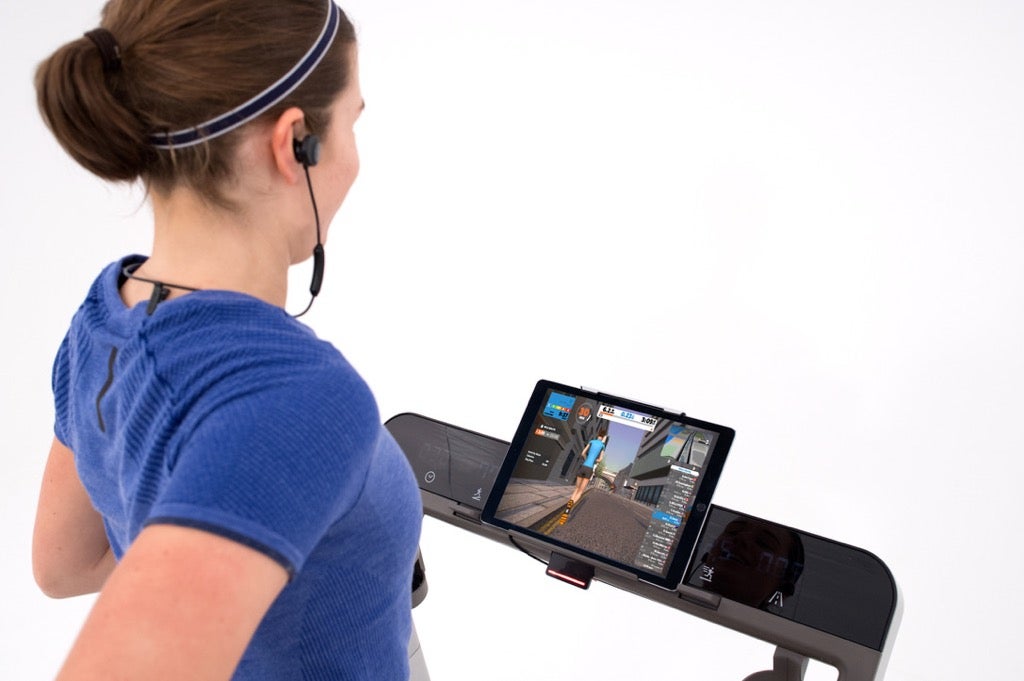Our First Impressions of Zwift's Run Platform

Photo provided by Zwift
Zwift is aiming to see if two feet have as much traction as two wheels, giving runners a similar social, measurable, virtual-reality experience.
Would Zwift be as fun for running as it is for cycling? The company is betting yes with the official launch of Zwift Run last Thursday. Technically, the platform has been out for a while and is still in beta, but Zwift is inviting runners to join the party while it’s still getting started.
To play, you only need a footpod (see supported sensors here), a heart rate monitor if you choose, and a screen—you could use a PC or Mac if you have your own treadmill setup; you’ll need an iOS device if you’re using a machine in the gym (an Android version is still to come). Just be aware that bigger is better when it comes to the screen, especially if you’re older than thirtysomething—there’s a lot of info there you’ll want to see. If you have access to a smart treadmill, this integrates seamlessly with those. In general, I find setting up tech to be even more tedious and frustrating than doing physical therapy exercises, but this was a breeze. (I tested it with a Stryd footpod.)
Zwift cycling users will see many of its classic features on the run. If you feel you’ve traveled the same roads before, it’s because you have: Runners travel the same courses as cyclists, and you may see some of your favorite riders zip past you. (One of the beauties of a virtual world, of course, is that cyclists and runners get along just fine. No cursing, no collisions.)
As with cycling, you can see who’s nearby and join virtual races—recent events included 5Ks, 10Ks, and half marathon training runs. If you don’t want to race or just run a route, there’s a small list of workouts under Run Type (eight of them right now, including some nice, classic interval options) that the company has big plans for expanding. It envisions specific training plans for a variety of distances, plus the eventual addition of pacers and some new roads and trails. Runners, like cyclists, can earn experience points and unlock virtual goods.
Some indoor runners love the fact that running in this virtual world makes cred in the real world a lot easier to obtain: Treadmill runs can be posted to Strava right from the Zwift app, and can also count toward Strava challenges.
Zwift won’t change treadmill speed for you, which makes sense: In the unlikely event that you can’t keep up on the run, “off the back” acquires a whole new literal and painful new meaning. And messaging while running is an option, but it’s a fine art you’ll have to figure out whether you can master.
Zwift says its half a million cyclists have found it to be more than just a “weather workaround.” And indeed, it may be a “motivation workaround,” meaning that it does have a way of adding some extra energy to those howevermany miles you were slated to do today. At the launch, Lionel Sanders said it “keeps him honest,” helping him push through some workouts when it’s tempting to make a different choice. And there really is something about being in a race, even if it’s virtual, with an official starting time and starting line with a collection of other real runners that helps bring out what you went in for.
Right now, the cost of joining your new, best buddies (who are free of body odor, free of farmer’s blow misfires, and free of bad boss stories) on Zwift Run is…free. That will change at some point, but right now, a footpod and a moment to download the app is all it takes to get in the game.